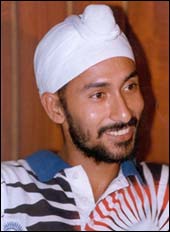Midfield holds the key to India's fortunes
Ivan Crasto
India begin their quest for a second World Cup crown on Sunday with a match against Japan. The Japanese have figured in the competition only twice before -- in 1971, when they finished ninth, and in 1973, when they slid a rung. Thus, taking their experience, or inexperience if you can call it, into account and the fact that they have never won against India in the World Cup or even internationally, the 1975 champions shouldn't have much difficulty in overcoming their first hurdle.
But success against Japan and in the subsequent matches can only come about by exercising control in the midfield. Indeed, it is that department which will be as vital as scoring goals from penalty-corners and field play.
 Not since the days of Ajitpal Singh, Vasudevan Bhaskaran and M M Somaya, all former Olympian captains renowned for their midfield genius, has an Indian hockey team boasted of players as versatile in the link line. Baljit Singh Saini, S Thirumal-valavan, S S Gill, Arjun Halappa and Ignace Tirkey, the men who will be responsible for manning the half line, are some of the best playmakers in the country. They are young and experienced, and though they may not have the sagacity of the stalwarts named above, they certainly have the craft and temperament for big match play.
Not since the days of Ajitpal Singh, Vasudevan Bhaskaran and M M Somaya, all former Olympian captains renowned for their midfield genius, has an Indian hockey team boasted of players as versatile in the link line. Baljit Singh Saini, S Thirumal-valavan, S S Gill, Arjun Halappa and Ignace Tirkey, the men who will be responsible for manning the half line, are some of the best playmakers in the country. They are young and experienced, and though they may not have the sagacity of the stalwarts named above, they certainly have the craft and temperament for big match play.
Indeed, if Indian hockey has been on the ascendant in recent times and the team was able to make it through the Olympic qualifiers and win the Champions Challenge, much of the credit should go to the half line. A review of India's matches in the above mentioned tournaments shows it was the half line that was in the main responsible for the successes. It not only kept opponents in check by creating a bottleneck down the middle and blunting out attack from the flanks, but also provided the flurry of passes for the forwards to score.
At the World Cup too it won't be different. The midfield has to come good. And the key figure in this scheme of things will be Saini. The gangling star missed the Champions Challenge on account of injury but was conspicuous in the World Cup qualifier, where India finished fifth and made it to the final. Saini has been in the senior team for over a decade now, having made his international debut in the 1995 Indira Gandhi Gold Cup. With the experience of two Olympics (1996 and 2000), the last World Cup at Utrecht and several other international tournaments behind him, he will be the fulcrum around which the forward line will operate.
Ball possession is an important aspect of contemporary hockey. Saini has mastered this art over the years.
As center half he has a tough role to play in holding possession and creating openings for the forwards. Despite missing the final camp in Chennai, as he was recovering from chicken pox, coach Cedric D'Souza insisted on his inclusion. After all, D'Souza knows how wily he is in the business of holding and releasing the ball. Should he play this role to perfection, the team should have little difficulty in handling any opposition.
Like Saini, Thirumalvalavan has a wealth of experience. This will be his second World Cup, having played at Utrecht in 1998. He also played at the Sydney Games. The duo, along with Gill and young Tirkey, a key member of India's junior World Cup-winning team, will undoubtedly be the backbone of the team. Forwards Dhanraj Pillay, who will be playing in his fourth World Cup, Deepak Thakur, Sabu Varkey, skipper Baljit Singh Dhillon and Gagan Ajit Singh will bank on their promptings to effect the vital strike at goal.
So will goalkeeper Jude Menezes, and defenders Lazarus Barla and Dilip Tirkey, for support in defence. In sum, these midfield generals hold the key to India's quest for a second World crown.
Mail Sports Editor

